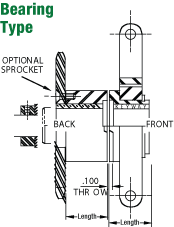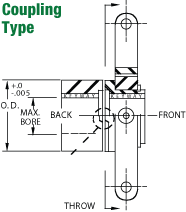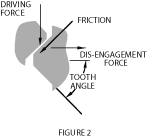Tooth Clutch Design

Our tooth clutches are available in a number of configurations to suit your requirements. The chart on the preceding page indicates the various dimensions available. These clutches can also be machined for your special applications where a standard size would not fit.
There are two types of tooth clutches available. The Coupling type has an internal keyway on the stationary and the shifter side. The Bearing type is fitted with a bearing on the stationary side and a keyway on the shifter side. Both of these types are illustrated here and on the preceding page.

The standard tooth clutch has 3 straight teeth spaced 60 degrees apart with each tooth occupying approximately 60 degrees space. The jaws are counterbored for clearance and ease of engaging and disengaging.
All of our tooth clutches, whether coupling or bearing type, have the option of a shifter assembly mounted on the shifter or sliding side of the clutch. Please note the diagram on the preceding page. This assembly consists of a sleeve with two shoulder bolts inserted on opposite sides of the sleeve. The sleeve is held axially in place with a retaining ring. The shifter fork fits over the sleeve and is held in place by the two shoulder bolts. The actuating arm on the shifter fork is usually sized 6” by 6” from the centerline of the shaft to the center of the holes. A non-standard size can be ordered at an additional cost.
The shifter assembly allows the shifter side of the clutch to engage and disengage axially while the clutch is either rotating or still. The actuating arms of the shifter fork have bolt holes for mounting. The lower arm can be mounted to a clevis-mounted stationary pin which allows the assembly to pivot when the upper arm is actuated by some physical movement. The size of the bolt holes in the actuating arms is listed on the chart on the preceding page. These clutches are case hardened and the torque capacities are very high. The 3” tooth clutch has a rating of 1400 ft. pounds and the 6” tooth clutch has a rating of 5000 ft. pounds. Usually, the shaft would be weaker than the clutch and would probably shear prior to the failure of the clutch. Compared to other tooth clutches on the market you will find these to be very economical.

We recommend three teeth when possible since that gives you both strength and economy. With one tooth it becomes a single position clutch. More teeth will allow earlier engagement at slow speeds. However, any tooth form can be supplied based on your requirements. The engagement force required to hold the sliding jaw against the other jaw is determined by the tooth angle. See Figure 2. Notice that the disengagement force will increase with tooth angle. Due to the friction force between the teeth there is an angle at which the net disengagement force is zero. This angle varies with such factors as lubrication, misalignment, shaft diameter, etc., and runs in the neighborhood of 25 degrees. For this reason, a straight-sided tooth (tooth angle = 0) will drive any load the shaft and key will carry and there will be no net disengagement force along the shaft.
Note the different tooth forms on the preceding pages. The neutral tooth form has a tooth angle chosen to require none to negligible disengagement force so that the bearing load on the shifter sleeve is slight. The proportional form has a large tooth angle which causes a disengagement force that is proportional to the load and therefore can serve as an overload release. Of course, the bearing load on the shifter sleeve can become prohibitive; especially if there is any speed. Consult with the factory before specifying a proportional tooth.
In the bearing type clutch, the sliding jaw or shifter side is keyed to the shaft with a slip fit so that it can be moved along the shaft for engagement or disengagement with the stationary side or bearing jaw. The bearing (stationary) side rotates on the shaft when disengaged and rotates with the shaft when engaged. It is supported by a bronze, oil-impregnated bearing. The bearing jaw or stationary side (it does not move axially) can be driven by a sprocket, pulley, flywheel, gear, or the like. An example of a sprocket mounted to the bearing jaw is shown on the preceding page. It is mounted to the jaw with bolts. The O.D. of the bearing jaw can be provided with a keyway if desired.

The sliding jaw is motivated through the sleeve by the shifter fork one end of which is fixed and the other caused to move either manually, pneumatically, hydraulically, mechanically, or electrically.
The coupling type, as implied by its name, drives one shaft from another which is in line with it. The shafts can be different sizes. No provision exists for support of one shaft by the other in this particular unit and each must be self-supported. Misalignment can be tolerated up to about .020” radial and 1/2 degree parallel. The allowable misalignment can be increased by fitting the clutch teeth loosely but there may be more back-lash. Each jaw is keyed to its shaft and the sliding jaw is fitted so that it can easily be shifted.
Since the sleeve bearing provided is oil-impregnated no additional lubrication is required. When grease fittings or oil holes are requested, they can be provided. Oil or grease should be applied at the shifter sleeve periodically and a grease fitting or oiler can be installed on special order. A bronze sleeve can be provided at an additional cost.
Speed of engagement is dependant upon the inertia of driven and driving masses and the stiffness of shafts. Three hundred revolutions per minute is a typical speed but much greater speeds are possible either with or without energy -absorbing contrivances.
If you have a special application for a tooth clutch, we can help you work out a specially engineered model at a reasonable cost.